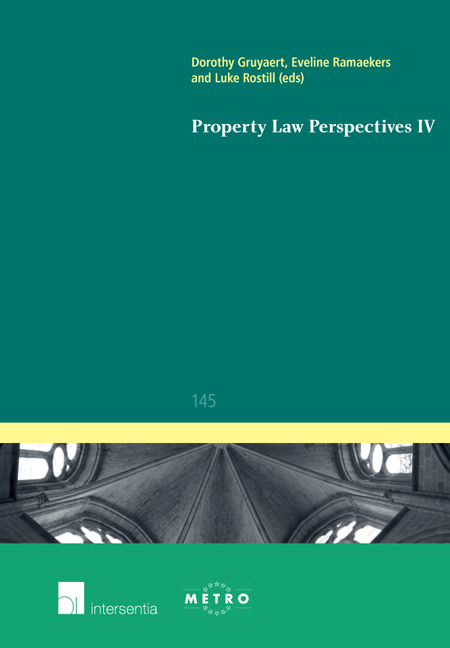Book contents
- Frontmatter
- Preface
- Contents
- Retention of Title v. Immovable Incorporation
- (Alternatives to) the Sale of Churches
- The First in Time Rule in Historical Context
- Paul Krugerbrug Revisited: State Action with an Excessive Impact on Property Rights from a Comparative Perspective
- The Reappearance of Ownership as a Means of Security in Mexican and French Law, the Battles Between Legal Technique and Legal Policy in Insolvency Law
- On the Unity or Disunity of Acquisitive and Extinctive Prescription. Or How Daring Reinterpretations are not Always Right
- Ius Commune Europaeum
The Reappearance of Ownership as a Means of Security in Mexican and French Law, the Battles Between Legal Technique and Legal Policy in Insolvency Law
Published online by Cambridge University Press: 21 September 2018
- Frontmatter
- Preface
- Contents
- Retention of Title v. Immovable Incorporation
- (Alternatives to) the Sale of Churches
- The First in Time Rule in Historical Context
- Paul Krugerbrug Revisited: State Action with an Excessive Impact on Property Rights from a Comparative Perspective
- The Reappearance of Ownership as a Means of Security in Mexican and French Law, the Battles Between Legal Technique and Legal Policy in Insolvency Law
- On the Unity or Disunity of Acquisitive and Extinctive Prescription. Or How Daring Reinterpretations are not Always Right
- Ius Commune Europaeum
Summary
Introduction
In Mexican and French law, the right of ownership is at the heart of several legal techniques that secure the performance of an obligation. The retention of title clause, the lease purchase agreement and the trust are examples of such techniques. The use of ownership as a means of security is nothing new; it was used in Roman law.
With the abolition of the nexum or debt bondage, the person of the debtor could not be used as collateral anymore. Therefore, the Romans created a trust like device, named fiducia cum creditore, to secure the payment of a debt. The settlor would transfer ownership to the trustee as collateral to secure the performance of an obligation; where the trustee would be the creditor and the settlor, the debtor. Subsequently, if the settlor breached the contract, the trustee could sell the trust property and pay himself with the price paid. On the other hand, if the settlor performed his obligation the trustee returned the trust property.
In time this mechanism disappeared, giving way to new security devices, such as the pignus (pledge) and the hypotecha (mortgage). These techniques did not use ownership as a means of security in Roman law, nor do they in Mexican and French law. Even though the pledge and the mortgage continue to exist in Mexican and French law, the use of the right of ownership as collateral not only has reappeared; it has been successful. This is quite astonishing because the pledge and the mortgage are more sophisticated mechanisms.
Even if we know that the refinement of a legal system does not prevent the revival of ancient techniques and therefore that the law has ‘cyclical movements: institutions are born, eclipse and reappear’, we cannot avoid enquiring upon these reappearances because at first instance it seems unreasonable. Thus, we can ask ourselves the following question: if the right of ownership ceased to be used to secure the performance of an obligation under Roman law, why has it reappeared in Mexican and French contemporary law?
- Type
- Chapter
- Information
- Property Law Perspectives IV , pp. 81 - 94Publisher: IntersentiaPrint publication year: 2016



